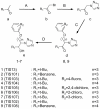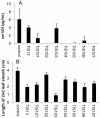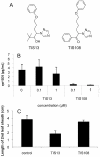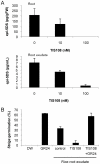Effects of triazole derivatives on strigolactone levels and growth retardation in rice
- PMID: 21760901
- PMCID: PMC3132747
- DOI: 10.1371/journal.pone.0021723
Effects of triazole derivatives on strigolactone levels and growth retardation in rice
Abstract
We previously discovered a lead compound for strigolactone (SL) biosynthesis inhibitors, TIS13 (2,2-dimethyl-7-phenoxy-4-(1H-1,2,4-triazol-1-yl)heptan-3-ol). Here, we carried out a structure-activity relationship study of TIS13 to discover more potent and specific SL biosynthesis inhibitor because TIS13 has a severe side effect at high concentrations, including retardation of the growth of rice seedlings. TIS108, a new TIS13 derivative, was found to be a more specific SL biosynthesis inhibitor than TIS13. Treatment of rice seedlings with TIS108 reduced SL levels in both roots and root exudates in a concentration-dependent manner and did not reduce plant height. In addition, root exudates of TIS108-treated rice seedlings stimulated Striga germination less than those of control plants. These results suggest that TIS108 has a potential to be applied in the control of root parasitic weeds germination.
Conflict of interest statement
Figures




Similar articles
-
A new lead chemical for strigolactone biosynthesis inhibitors.Plant Cell Physiol. 2010 Jul;51(7):1143-50. doi: 10.1093/pcp/pcq077. Epub 2010 Jun 3. Plant Cell Physiol. 2010. PMID: 20522488 Free PMC article.
-
Effects of strigolactone-biosynthesis inhibitor TIS108 on Arabidopsis.Plant Signal Behav. 2013 May;8(5):e24193. doi: 10.4161/psb.24193. Epub 2013 Mar 19. Plant Signal Behav. 2013. PMID: 23511201 Free PMC article.
-
Optimization of the KK5 Scaffold and Biological Evaluation of KK5 Derivatives to Identify Potent Strigolactone Biosynthesis Inhibitors.J Agric Food Chem. 2025 Jun 18;73(24):15389-15398. doi: 10.1021/acs.jafc.5c01991. Epub 2025 Jun 6. J Agric Food Chem. 2025. PMID: 40480961
-
Regulation of biosynthesis, perception, and functions of strigolactones for promoting arbuscular mycorrhizal symbiosis and managing root parasitic weeds.Pest Manag Sci. 2019 Sep;75(9):2353-2359. doi: 10.1002/ps.5401. Epub 2019 Apr 5. Pest Manag Sci. 2019. PMID: 30843315 Review.
-
Strigolactones: structures and biological activities.Pest Manag Sci. 2009 May;65(5):467-70. doi: 10.1002/ps.1726. Pest Manag Sci. 2009. PMID: 19222028 Review.
Cited by
-
Increase in ENHANCER OF SHOOT REGENERATION2 expression by treatment with strigolactone-related inhibitors and kinetin during adventitious shoot formation in ipecac.Plant Cell Rep. 2023 Dec;42(12):1927-1936. doi: 10.1007/s00299-023-03073-y. Epub 2023 Oct 6. Plant Cell Rep. 2023. PMID: 37803214
-
Gene expression profiling before and after internode culture for adventitious shoot formation in ipecac.BMC Plant Biol. 2022 Jul 22;22(1):361. doi: 10.1186/s12870-022-03756-w. BMC Plant Biol. 2022. PMID: 35869421 Free PMC article.
-
Fenoxycarb, a carbamate insect growth regulator, inhibits brassinosteroid action.J Pestic Sci. 2023 Aug 20;48(3):107-110. doi: 10.1584/jpestics.D23-015. J Pestic Sci. 2023. PMID: 37745175 Free PMC article.
-
Strigolactone signaling inhibition increases adventitious shoot formation on internodal segments of ipecac.Planta. 2021 May 20;253(6):123. doi: 10.1007/s00425-021-03640-1. Planta. 2021. PMID: 34014387
-
Strigolactones and Cytokinin Interaction in Buds in the Control of Rice Tillering.Front Plant Sci. 2022 Jul 1;13:837136. doi: 10.3389/fpls.2022.837136. eCollection 2022. Front Plant Sci. 2022. PMID: 35845690 Free PMC article.
References
-
- Cook CE, Whichard LP, Turner B, Wall ME, Egley GH. Germination of Witchweed (Striga lutea Lour.): Isolation and Properties of a Potent Stimulant. Science. 1966;154:1189–1190. - PubMed
-
- Akiyama K, Matsuzaki K, Hayashi H. Plant sesquiterpenes induce hyphal branching in arbuscular mycorrhizal fungi. Nature. 2005;435:824–827. - PubMed
-
- Gomez-Roldan V, Fermas S, Brewer PB, Puech-Pagès V, Dun EA, et al. Strigolactone inhibition of shoot branching. Nature. 2008;455:189–194. - PubMed
-
- Umehara M, Hanada A, Yoshida S, Akiyama K, Arite T, et al. Inhibition of shoot branching by new terpenoid plant hormones. Nature. 2008;455:195–200. - PubMed
-
- Beveridge CA, Kyozuka J. New genes in the strigolactone-related shoot branching pathway. Curr Opin Plant Biol. 2010;13:34–39. - PubMed
Publication types
MeSH terms
Substances
LinkOut - more resources
Full Text Sources
Other Literature Sources

